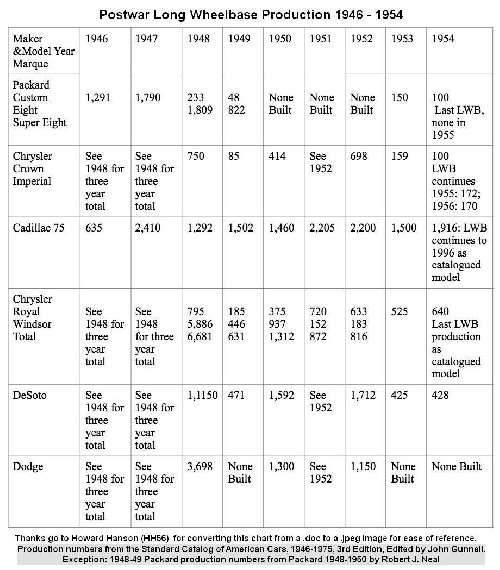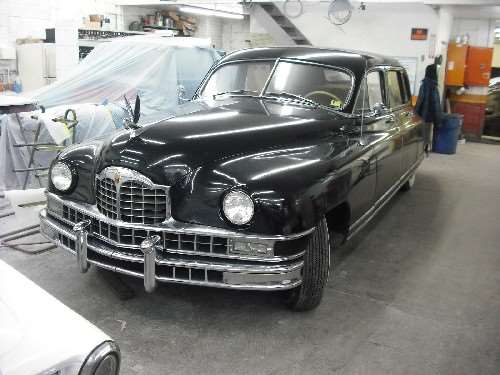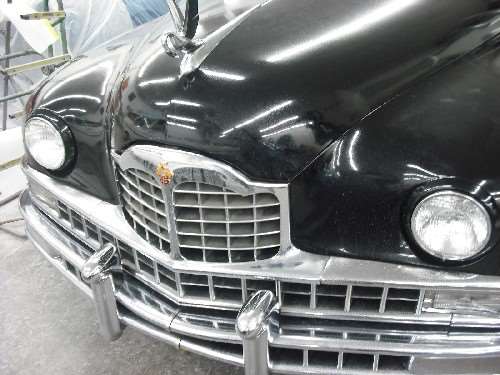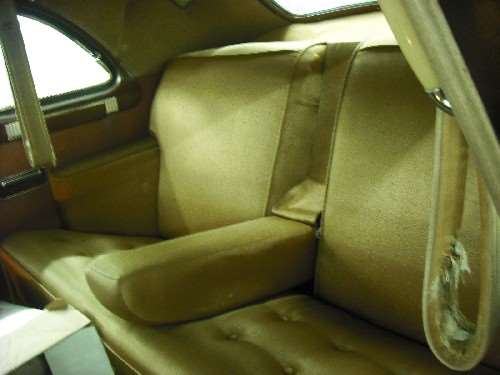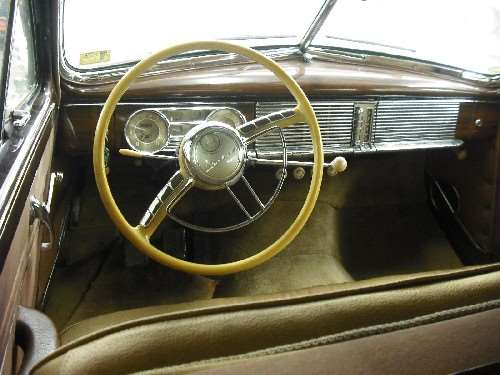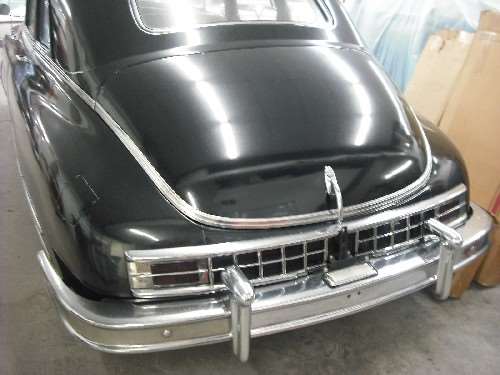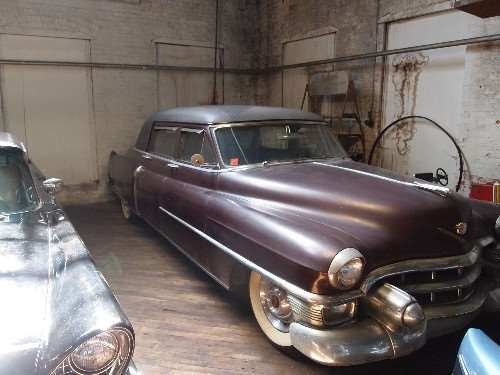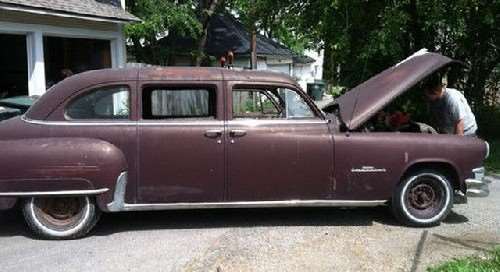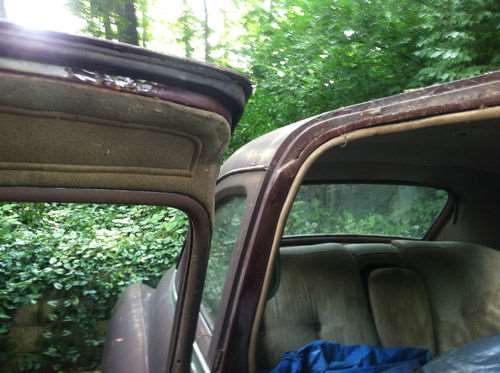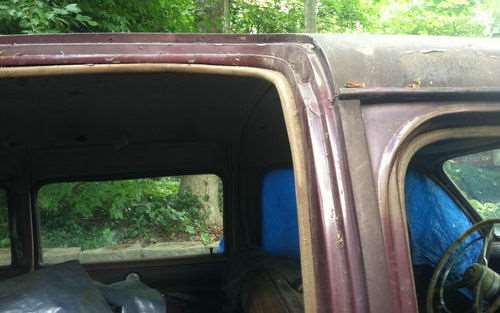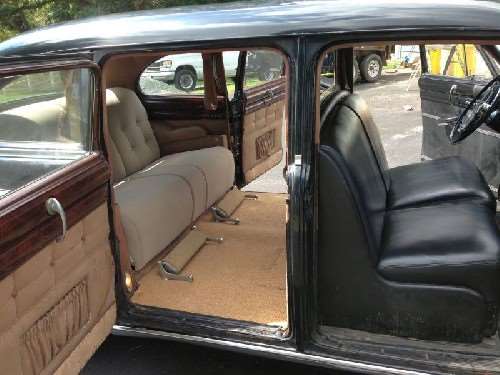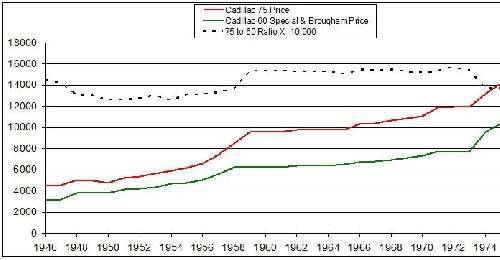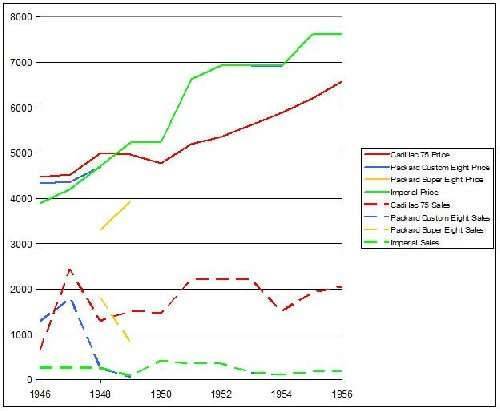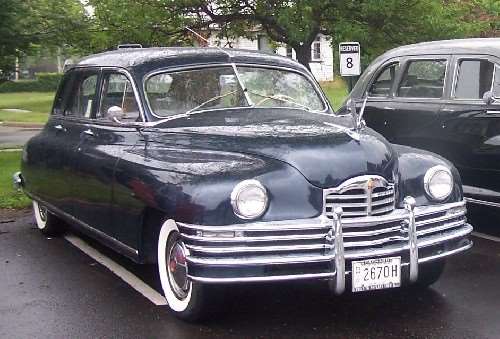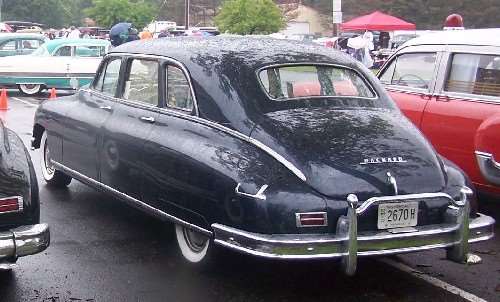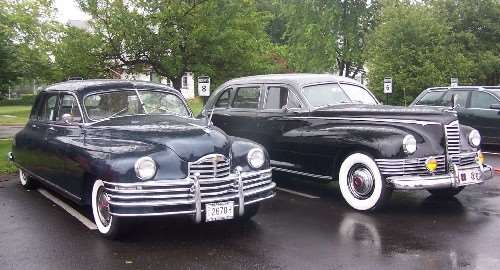|
Re: Postwar LWB Market Production
|
||||
|---|---|---|---|---|
|
Home away from home

|
Hi
Not infrequently when pondering Packard's postwar slide, the idea persist that the consistent availability of seven passenger sedans and limousines could have bolstered their prestige car reputation; conversely the lack thereof being a contributor to their demise. This set off a survey of the results for not only luxury model lwb makers but also to included all makers of such cars from 1946 through 1954. This exercise confirmed a hunch and lead to some surprising conclusions. Of Packard's experience in the immediate postwar years, there was reason for optimism since the lwb Custom Super Clippers actually slightly outsold the comparably-priced Cadillac 75's for 1946-47 when averaged for those two years. The lwb Clippers presented a more modern appearance given that Cadillac carried over mildly-restyled 1942 75's through the 1949 model year. But, for East Grand Boulevard, it would be the last time their lwb offerings were a real market factor. With the restyled 22nd Series and a broadened lwb line-up, the new 1948's seemingly promised even better business. That changed but not as expected, when as Robert Neal wrote, in response to dealer and operator requests, management developed the 141"wb Super Eight seven passenger sedans and limousines in both standard and deluxe versions to supplement the existing 148" wb Custom Eight models. Priced $1,000 to $1,400 lower than the Customs, customer preference quickly switched, the Super Eight cannibalized Custom Eight sales, dropping the latter to 9.6 percent of 22nd-23rd Series lwb totals. Mr. Neal detailed how 22nd Series overproduction in general versus market demand resulted in masses of leftover cars including the lwb models. Re-numbering and discounting followed to clear slow-selling inventory. It took all the way through the 1950 selling season to move the last of the re-numbered leftover 22nd Series lwb cars. Ultimately that curtailed completely proceeding with the 1949-50 23rd Series lwb production. The resultant perceived failure of the 22nd-23rd Series lwb efforts discouraged further pursuit of that segment during the 1951 24th Series development, regardless of such proposals developed by Henney. Overall, this experienced affectively ended Packard's participation in one of their traditionally successful market segments. Now, what of their other direct luxury segment competitors, the Cadillac 75 and the Chrysler Crown Imperial. Cadillac first, because its the simplest to explain. Carrying over a restyled 1942 wasn't so unusual for those years, though by 1949 doing so without damaging their market position speaks of the strong sales momentum Cadillac had established. The holdover of a pre-war bodied 75 occurred as the volume luxury market was their main emphasis initially, the lwb models simply had to wait. When their first all-new 1950 75 appeared, it had up-to-date styling consistent with the Series 61, 62 and 60 Special. That 1950 body lasting through 1953, the new 1954's entered a market with effectively no competition. From this year forward, the Cadillac 75 became dominant. The Chrysler Crown Imperial was for the most part a placeholder, keeping the model name 'Imperial' alive. The main thing to keep in mind about all Chrysler Corporation lwb offerings is they all shared a common body shell whether a lowly Dodge or DeSoto taxi/livery stage-line or a elegant Crown Imperial. That volume amortization made the low-volume luxury vanity possible; credit DeSoto, it being the major player in both retail and fleet sales. With 1949 model, even Mopar volumes plummeted. Some might be attributed to late start-up in general of the all-new 1949 bodies, given the lwb market was relatively small, a peripheral segment to be served after the mass-market ramp-up. What is unknown is if Chrysler ended the 1948-early 1949 run with masses of leftover lwb cars to move firsthand before proceeding with the new lwb production. When Chryslers did get back into the swing in 1950, surprisingly the Crown Imperial showed comparatively well in spite of a higher price versus the also all-new Cadillac 75. The Crown Imperial held up well through 1952 then tapered off to levels consistent with Packard's last lwb foray. The Crown Imperial persisted as an in-house effort during 1955-1956 at minimal levels, 172 and 170 respectively. Then, the full-custom Ghia coach-built Crown Imperial limousines would carry on into the mid-'60's. What of those lwb cars below the Cadillac 75, Packard Custom Eight and Crown Imperial? The brief preference shown for the 22nd Series Super Eight lwb cars lead Packard nowhere. All six cylinder Mopar models sold at prices below even the lwb Super Eight; served primarily the taxi/mass-transport fleets. Soon this segment changed it preference to standard five-six passenger sedans. Part of the motivation for the change was the revision of minimum passenger capacity demanded by cities for their taxi fleets. The lwb DeSoto Skyview, once so ubiquitous, frequently seen in old movies, largely disappeared by the mid-1950's. The above chart doesn't include lwb taxis but reflects their story as well. Overall, it was a diminishing market well below the Cadillac 75 price level and that consolidated on the 75 almost completely, essentially the only game in town. Surveying their results, Packard management's response to dealer and operator requests for less expensive lwb cars basically shot themselves in the foot. This is not an indictment of the cars themselves but of the initial management decision and mismanagement of production versus demand. Not only did it largely kill Custom Eight lwb sales, the lower-priced Super Eight oversupply lead to slow-selling models that had to be discounted to clear from inventory. Since their prior lwb Custom Super Clippers sold versus the Cadillac 75, they would have done well to noticed that GM no longer allowed Buick to field a lwb Limited as it had through 1942. The Limited stood in the same market relationship to the 75 that Packard created with the 141" wb 1948 Super Eight, essentially more attractively-priced, internal competition for their own top-line cars. Unhappily, this experience discouraged further pursuit of the lwb market with the new Contour-styled 1951 models, though the Henney-developed proposals would finally see the light of day. When Nance pushed through that last effort for 1953-1954, their prestige value was questionable in a market where a continuing tradition of availability was important, such sales momentum had already been lost. This foray too resulted in slow-selling, discounted inventory and discouraging results. Whether the Henney Company failed or not in 1954, lwb V8 models may not have found a much more acceptable reception. While its a shame we haven't many postwar lwb Packards to preserve and enjoy, in a consolidating market, they may not have had much chance to succeed even if they continued to field such cars. Thanks for reading my latest diatribe. Your comments and observation invited. Steve Correction: Desoto total for 1946-1948 should read 11,150.
Posted on: 2016/2/17 15:14
|
|||
|
.....epigram time.....
Proud 1953 Clipper Deluxe owner. Thinking about my next Packard, want a Clipper Deluxe Eight, manual shift with overdrive. |
||||
|
||||
|
Re: Postwar LWB Market Production
|
||||
|---|---|---|---|---|
|
Home away from home

|
Excellent analysis Steve! Enjoyed it thoroughly and your conclusions are spot on. As you make clear, consistent availability of LWB cars was critical to staying in the forefront of the imagination of the moneyed clientele that Packard had long courted. Even after Packard switched to "Junior" platforms exclusively in 1940, their long wheelbase versions couldn't help but look impressive. The Clipper-based versions were particularly well-done.
Cadillac fell behind in these years. I've heard that the Caddy limos were fabulous to ride in, but I doubt Cadillac Design was content as they gazed at the new Henney-built Packards. The 1950 Cadillac was a much better effort, the type of car the designers probably had wanted back in 1946. Conversely, the '53 Packard Executive didn't have nearly the unique appearance that the earlier Packards and concurrent Cadillac had, being nothing more than a coupe mated to a sedan. Subjective styling observations aside, its biggest problem was price. At $6900 it was $1300 more than the Series 75. This was a mistake on Nance's part, who approved Packard sending kits to Henney to build the car from scratch. There was no way Henney could approach the build efficiency of Packard. It was one thing to build hearses, which had mostly unique elements. The Executive, by contrast, was mostly stock Packard. A better strategy would have been to have Henney create the unique parts - rear doors, roof and floor pan extensions - and ship them to Briggs (Conner) where the cars could be built efficiently alongside the rest of the line. Always liked the '54 Imperial, a real looker and very refined, if dated by then.
Posted on: 2016/2/25 21:10
|
|||
|
||||
|
Re: Postwar LWB Market Production
|
||||
|---|---|---|---|---|
|
Forum Ambassador

|
A friend of mine just did some body work on this car - it is going to auction shortly. 148 inch wheelbase - great interior.
Posted on: 2016/2/26 20:24
|
|||
|
||||
|
Re: Postwar LWB Market Production
|
||||
|---|---|---|---|---|
|
Forum Ambassador

|
Early car (painted headlight rims). Wonder if it might have been one of the White House or State Dept. fleets?
Thanks for the pictures, Randy.
Posted on: 2016/2/26 20:37
|
|||
|
||||
|
Re: Postwar LWB Market Production
|
||||
|---|---|---|---|---|
|
Home away from home

|
Hi Gentlemen
Thanks for your responses. Randy, thanks for the photos of the impressive Custom Eight. Dave, thanks for mentioning the Federal government use of these cars where some of the 22nd Series over-production was cleared. Thanks Paul for enlarging on important points that need further emphasis. Continuity was very important to clients of these cars bought not only for luxurious transportation but also the prestige image they conveyed. Proof of that can be seen in that while Cadillac carried over their pre-war 75 well into the postwar years, it had no deleterious affect on their sales. Once the 75 was updated, it moved simply from strength to strength. Appearance of a 75 conferred prestige without question, no more Buick Limiteds to confuse that. Although largely based on the volume Series 62 body, its styling was carefully tailored to project a uniquely formal, elegant aura. When considering whether to field the 1948 Super Eight lwb cars priced below the Custom Eight, management should have taken note of Chrysler's experience in that market. It was relatively successful for the general utility/livery/taxi segment covered by Dodge/Desoto/Chrysler Royal-Windsor but far less so for the Crown Imperial. Exposure of those utilitarian models detracted from the Imperial's prestige image. Although the Super Eights weren't quite so down market, a gaggle of them gathered in front of a railroad or airport passenger pick-up driveway discouraged the Custom Eight limousine owner from another Packard when seeking a prestigious car trade. Nominally Henney should have been able to give the '53-'54 Executive models the raised roofs and upper door frames cut higher into that roof which was becoming expected of formal cars. Splicing a sedan and coupe together, without formal backlight, just didn't quite do it. From what Mr. Neal wrote, Henney wasn't cutting Packard any deal when it came to contracting for their construction. Just as it did with their general body construction, locking themselves into one coachbuilder for commercial-livery-formal bodies without competition turned out to be a bad deal long term. Steve
Posted on: 2016/2/27 9:07
|
|||
|
.....epigram time.....
Proud 1953 Clipper Deluxe owner. Thinking about my next Packard, want a Clipper Deluxe Eight, manual shift with overdrive. |
||||
|
||||
|
Re: Postwar LWB Market Production
|
||||
|---|---|---|---|---|
|
Forum Ambassador

|
.....locking themselves into one coachbuilder for commercial-livery-formal bodies
Not that there were many choices available to them. Just for a little comparison this Cadillac 75 delivered February 1953. Photo from the Kanter collection. VN 5375-1XXXX.
Posted on: 2016/2/27 9:42
|
|||
|
||||
|
Re: Postwar LWB Market Production
|
||||
|---|---|---|---|---|
|
Home away from home

|
Hi Dave
Quite true, their sources were diminishing, though there were other commercial coachbuilders such as Ionia, Superior or Hess and Eisenhardt who could have been approached. Of Briggs work for Chrysler, this '51 Crown Imperial turned up on eBay a few years ago. Looks like normal production until one notices the rear doors are cut into the roof. The seller noted it was thought to be Walter Briggs' last limousine. And a '52 for comparison. Steve
Posted on: 2016/2/27 10:44
|
|||
|
.....epigram time.....
Proud 1953 Clipper Deluxe owner. Thinking about my next Packard, want a Clipper Deluxe Eight, manual shift with overdrive. |
||||
|
||||
|
Re: Postwar LWB Market Production
|
||||
|---|---|---|---|---|
|
Home away from home

|
I threw some sales and pricing numbers in an excel file to see how it all looked in graphical form. Steve - I'll send you the file.
First chart shows Cadillac 75 vs. 60 Special and later Brougham. Dotted line is price ratio of 75 to 60 multiplied by 10,000 to get it to show up on the graph. It clearly shows that once the LWB competition vanished after 1954 for Packard and 1956 (effectively) for Imperial, Cadillac quickly increased its LWB price. For example, in 1954 the 75 was 25% higher than 60 Special but by 1959 it was 53% higher. Shrewd business folks, those Cadillac leaders! Volumes didn't suffer much in the Sixties and Seventies, the market seemed to simply absorb the increase. Second chart shows sales and pricing for the three LWB luxury models through 1956. I also included the 1948-9 Super Eight. As Steve explained, Packard sales and pricing were both competitive with Cadillac in 1946-47. In 1948 the addition of the lower priced Super Eight cannibalized the Custom's sales. In 1949 when the Super Eight's price increased, sales dropped. One could look at all the data several ways but one way is to observe that both marques sold around 5900 LWB cars between 1946-49 and with similar pricing, but for Packard, 2600 of them were the much lower priced Super Eights and the marque had to absorb the expense of a major restyle while Cadillac 75 held pat. In the 1950s, Imperial and Packard pricing was far enough above Cadillac to torpedo them despite any special attributes they may have had (and the 1955-56 Imperial had several). Am not sure why Imperial pricing was so high but for Packard, it is clear that Henney was the wrong outfit to make the car. I doubt any outside outfit could have done much better price-wise. Packard needed to follow Cadillac and do the work in-house. To do so, it needed enhanced body operations in Conner. It's always easy to look back and point fingers but I do wonder why Nance didn't make the purchase of Conner a top priority long before Chrysler bought them. I get the money thing, but Packard's stock-in-trade had always been a robust catalogue of body styles, the result of a flexible and impressively creative in-house body shop. Had Nance set up within Conner efficient off-line operations to cut and weld inserts for doors, roofs and floorpans, the number of body styles could have proliferated to Packard's great advantage. For example, the simple addition of 5 inches to the '53 Clipper sedan's front and rear doors could have produced a 132 inch wheelbase car of similar length to the 60 Special that, while not having the aircraft carrier rear deck of the 60, wculd have had old school rear legroom that Packard's older customers would have loved. And the car could have easily accommodated an optional division window, allowing Packard to put out an entry limo priced much lower than the 75. There was even more that Packard could have done in 1953-54 with such body capability, such as lowering the hood and beltline of the hardtop and including a longer 4-door version, to create a sport series to take on Coupe DeVille, Eldorado and eventual Sedan DeVille. Probably the hood and fenders would have needed tooled new but you get the idea. Ah well...
Posted on: 2016/2/27 14:27
|
|||
|
||||
|
Re: Postwar LWB Market Production
|
||||
|---|---|---|---|---|
|
Home away from home

|
Hi Paul
Thanks for graphing the sales and pricing data, it makes it much more understandable than having to wade through those numbers on the chart. Most startling is how quickly the effort to broaden the 22nd Series lwb program ended in disaster. It would be a reasonable assumption that management did so thinking the Custom Eight sales would hold or increase, be supplemented by the additional Super Eight volume given those essentially had no price competition in that segment. Christopher and Briggs would both have been vindicated had that come to pass. Only the action of moving lwb body production from Henney to Briggs may have kept this from becoming an even more costly debacle. Of the last round at the lwb 'carriage' trade for 1953-54, it worked out about as well. Henney cut them no deal to build the cars, then the marketplace gave them such an indifferent reception that heavy discounting was necessary to clear even the small numbers made. An in-house effort to create a true 60 Special competitor i.e. a lengthened six passenger sedan with distinctive, exclusive styling would have been a better gambit. As far as why Crown Imperials were so expensive, perhaps their unique disk brake system added significant cost, certainly wasn't the shared Mopar body contributing. Just a hunch that Chrysler management preferred to be chauffeured in their own top-line car whether it was a costly vanity or not. Indeed, Cadillac management took full advantage of being the only lwb game in town. Its unlikely the cost to engineer and tool each new body series increased anything like the retail price did. Definitely there was a prestige boost for the entire line to be preceived as offering the most expensive cars available each model year, to say nothing of being the standard equipage of the wealthy and powerful. Here's a few photos of a 22nd Series Super Eight lwb at the PAC National Meet at Warren, Ohio in 2014. It was a washout but the show went on. Though it and the Custom Super Clipper lwb weren't parked to accurately compare for length, the latter cuts a more impressive figure. Steve
Posted on: 2016/2/28 17:13
|
|||
|
.....epigram time.....
Proud 1953 Clipper Deluxe owner. Thinking about my next Packard, want a Clipper Deluxe Eight, manual shift with overdrive. |
||||
|
||||


 (121.92 KB)
(121.92 KB)